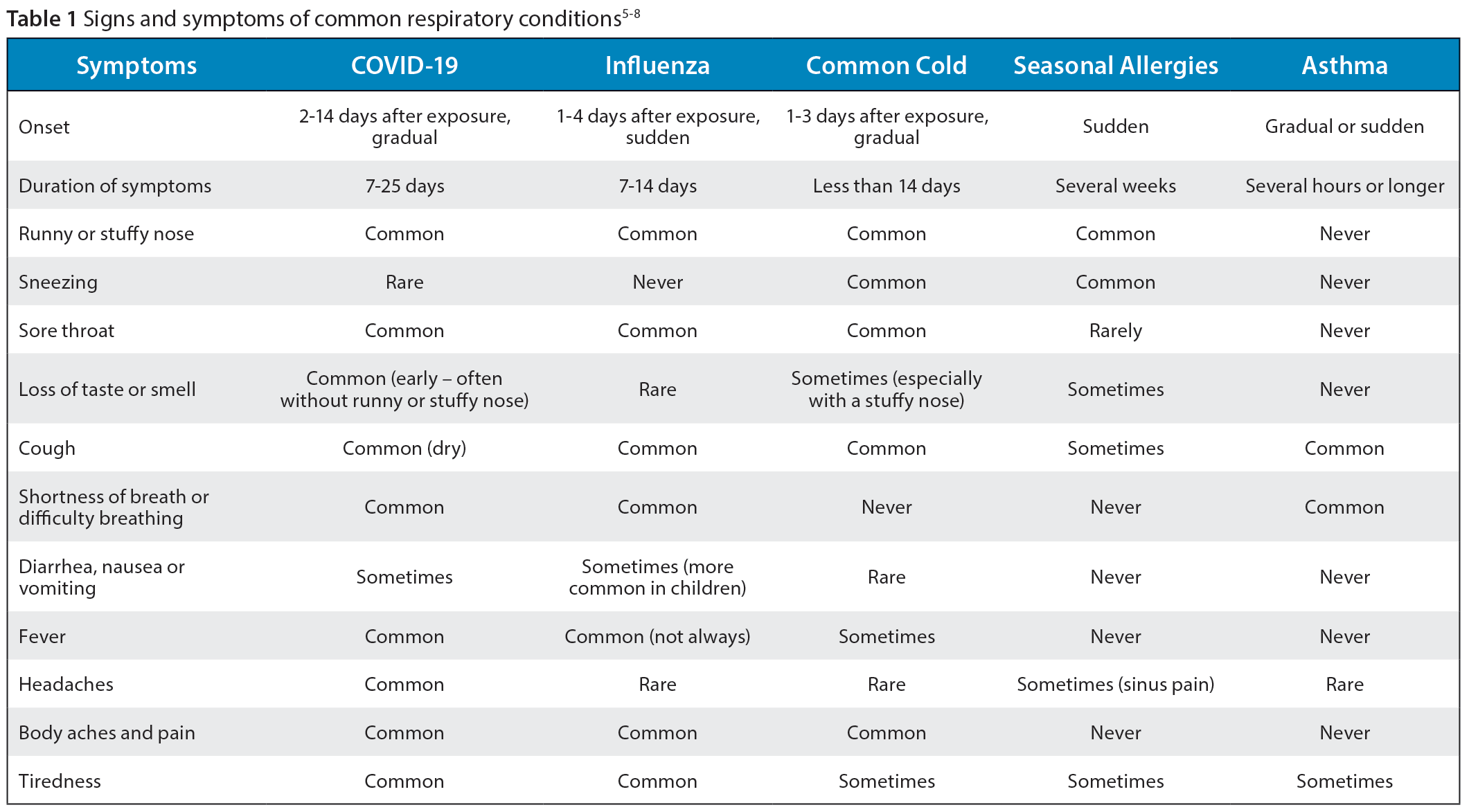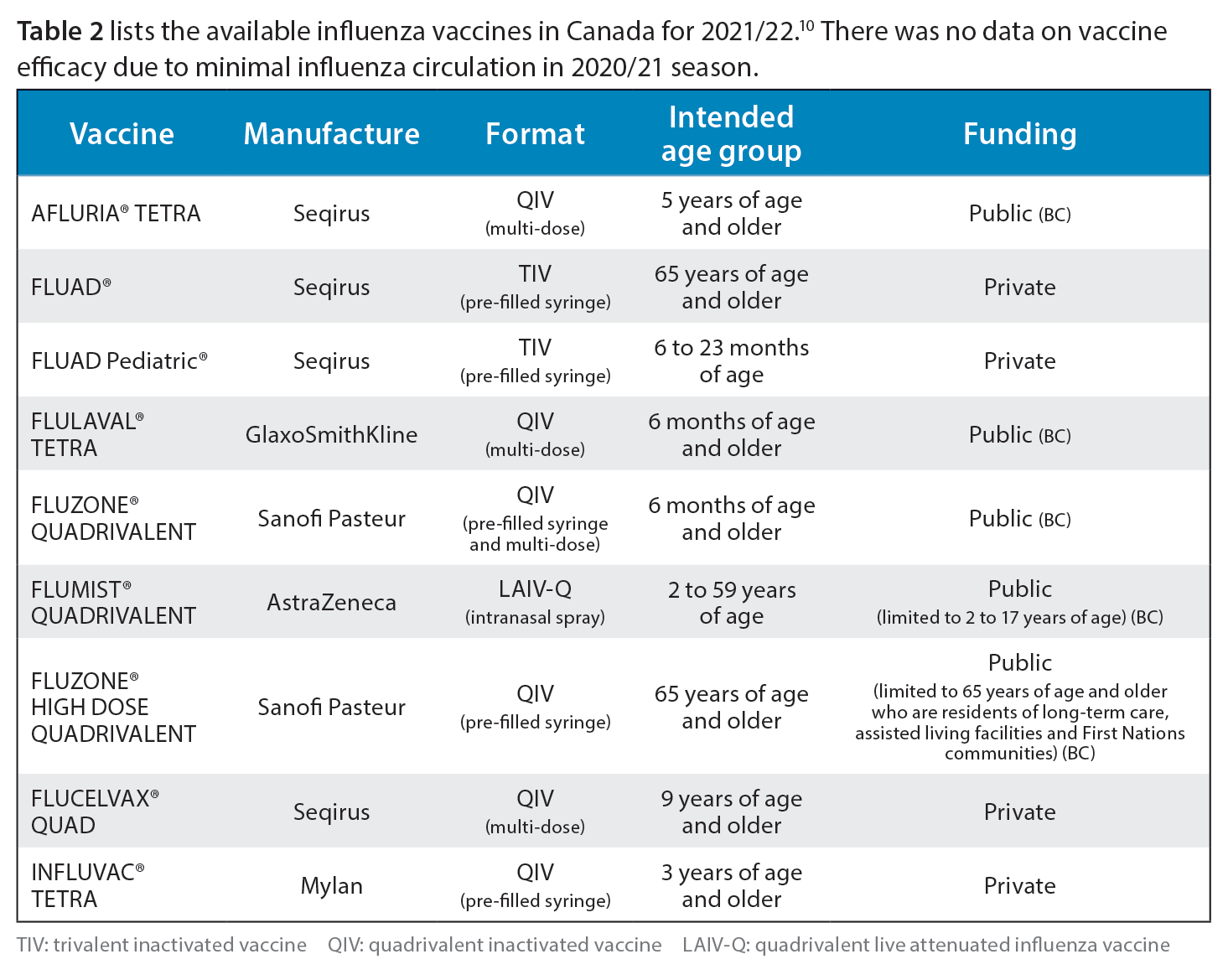Sponsored by Sanofi
By Sandy Lu, BSc (Hons), BSc (Pharm), MScPH, RPh.
Reviewed by Joyce Seto, Pharmacy Manager, Vaccine and Pharmacy Services, BC Centre for Disease Control.
The term “twindemic”, first coined by Jan Hoffman in The New York Times in August 2020, refers to the influenza epidemic occurring alongside the COVID-19 pandemic. A twindemic did not occur during the 2020/21 season much to everyone’s relief. In fact, seasonal influenza cases were at historic lows worldwide. The WHO Global Influenza Surveillance and Response System (GISRS) laboratories tested more than 5,173,255 samples from up to 102 countries during the period of September 28, 2020 to August 29, 2021. Of which, only 14,395 (0.28%) were positive for influenza virus, with 4,912 cases being influenza A and 9483 cases being influenza B.1 In British Columbia, a total of 18 cases were detected from almost 90,000 tests between September 27, 2020 to August 28, 2021.2 The lower positivity rates were attributed to containment measures for COVID-19 globally and locally - latter, such as school closures, travel restrictions, masks, physical distancing, hand hygiene and influenza vaccinations.
British Columbia is currently in Phase 3 of BC’s Restart Plan for COVID-19. As public health takes a measured approach to lifting restrictions, this relaxation and complacency could have implications for the transmission of respiratory diseases. Many health experts are revisiting their concerns of the possible twindemic for the 2021/22 influenza season.3 Children, a cohort of concern, are highly susceptible to serious complications from respiratory infections, and as children under 12 years of age are currently unvaccinated due to age ineligibility for COVID-19 vaccines, these concerns may be warranted. Since July 2021, there has been an increased proportion of BC Children’s Hospital visits attributed to influenza-like illness (ILI). During the week of August 22, 2021 alone, ILI cases rose 7.8% above the historical 5-year average of 5.1% as the pandemic and detection of other respiratory viruses are contributing significantly to these findings 2 It is important for all children to be protected against influenza in recognition of the ongoing pandemic, the increase in other detected respiratory pathogens (enterovirus, rhinovirus, respiratory syncytial virus, and pneumococcal bacteria), and factoring co-morbidities. Moreover, it is important for everyone 6 months of age and older to receive their influenza vaccines.4
Similarities and differences between influenza and other respiratory conditions
COVID-19, influenza, common cold, seasonal allergies and asthma share many similar signs and symptoms (Table 1). It is important to understand key differences in symptoms that these conditions cause for effective response measures. Note that diagnosis cannot be made based on clinical presentations alone.

Influenza vaccines for the 2021/22 season
Influenza viruses undergo constant mutation commonly via antigenic drift, and to a lesser extent, antigenic shift.9 This is why vaccines are updated annually. The WHO provides recommendations on the strain components for the northern and southern hemispheres annually in February based on influenza surveillance. The 2021-2022 strains were based on much fewer cases globally than normal.
The strain components for the 2021/22 Northern Hemisphere influenza vaccines are:
- A/Victoria/2570/2019 (H1N1)pdm09-like virus *new this year*
- A/Cambodia/e0826360/2020 (H3N2)-like virus *new this year*
- B/Washington/02/2019 (B/Victoria lineage)-like virus
- B/Phuket/3073/2013 (B/Yamagata lineage)-like virus

Coadministration of influenza and COVID-19 vaccines
In the UK, one sub-study examined the safety and immunogenicity of influenza vaccine co-administered with a COVID-19 vaccine (NVX-CoV2373) as part of the phase 3 clinical trial.11 Adverse effects, such as tenderness/pain at injection site, fatigue and muscle pain, were reported to be greater in the co-administration group compared to the main study group. There was no change to the influenza vaccine immune response. Results of the sub-study is limited by several factors, such as: (1) reduced statistical power in subgroup analysis, (2) participants in sub-study are younger and have less co-morbid conditions, (3) funding bias.
As of September 28, 2021, Canada’s National Advisory Committee on Immunization (NACI) recommends that all influenza vaccines (inactivated, live, or adjuvanted) can be given at the same time as, or at any time before or after, administration of any other live attenuated or inactivated vaccines.10 This recommendation for influenza vaccinations applies also to the co-administration of COVID-19 vaccines. The precautionary approach of spacing non-COVID-19 and COVID-19 vaccines during the early stages of COVID-19 vaccine rollout no longer applies as Canada continues to gain evidence on the immunogenicity, safety, and effectiveness for COVID-19 vaccines. This updated recommendation enhances practices and opportunities with the concomitant administration of vaccines at the same visit and at different injection sites.
Creating safe and effective vaccine delivery in the community
Pharmacists play an even greater role this year in the provision of vaccine administration as distribution from pharmaceutical distributors will enable conventional access flows. With the upcoming influenza season and the recommendation for a third COVID-19 vaccine dose in specific at risk populations demand for influenza vaccine is expected to be high as pharmacists continue to be valued immunizations providers.
Here are some tips to ensure safe and effective vaccine delivery at your pharmacy:
- Make strong vaccine recommendations using the SHARE approach as this may help with vaccine hesitancy12:
- Share the reasons why an influenza vaccine is right for the patient
- Highlight positive experiences with the vaccine (personal or in practice)
- Address patient questions
- Remind patients that the vaccine helps to protect them and those around them
- Explain the potential cost of getting influenza, including potential health effects, time lost from missed work and family obligations, financial costs, potential spread to family and friends
- Providing enough physical space in and outside the pharmacy, for example, utilizing parking lots, community halls
- Create designated times for vulnerable and high-risk populations to come in for vaccinations
- Schedule appointments and limit walk-in’s
- Provide quiet space for post-immunization observation
- Offer other vaccines as indicated (ie. pneumococcal 23-valent polysaccharide vaccine)
- Check expiration dates and post-puncture periods of use
- Maintain good cold chain practice policies (PPP-68)
- Ensure epinephrine and anaphylactic kits are available and have not expired
- Pre-screen individuals for COVID-19 prior to their scheduled influenza vaccine appointments
- Maintain mask mandates, as per public health orders
References
1. World Health Organization. Global Influenza Programme - Influenza Update No 403. World Health Organization. [Online] September 27, 2021. https://www.who.int/teams/global-influenza-programme/surveillance-and-monitoring/influenza-updates/current-influenza-update.
2. BC Centre for Disease Control. Influenza Surveillance Reports - August 22 to 28, 2021 (Week 34). BC Centre for Disease Control. [Online] September 3, 2021. http://www.bccdc.ca/health-professionals/data-reports/communicable-diseases/influenza-surveillance-reports.
3. Rubin, Rita. Influenza’s Unprecedented Low Profile During COVID-19 Pandemic. 10, September 14, 2021, JAMA, Vol. 326, pp. 899-900.
4. BC Centre for Disease Control. Biological Products. BC Centre for Disease Control. [Online] August 2021. http://www.bccdc.ca/resource-gallery/Documents/Guidelines%20and%20Forms/Guidelines%20and%20Manuals/Epid/CD%20Manual/Chapter%202%20-%20Imms/Part4/Influenza_Eligibility.pdf.
5. How Can You Tell the Difference Between COVID-19, a Cold, the Flu, Allergies and Asthma? Asthma and Allergy Foundation of America. [Online] October 13, 2020. https://www.aafa.org/media/2631/respiratory-illness-symptoms-chart-coronavirus-flu-cold-allergies.png.
6. COVID-19, cold, allergies and the flu: What are the differences? Mayo Clinic. [Online] May 18, 2018. https://www.mayoclinic.org/diseases-conditions/coronavirus/in-depth/covid-19-cold-flu-and-allergies-differences/art-20503981.
7. Similarities and Differences between Flu and COVID-19. Centres for Disease Control and Prevention. [Online] June 7, 2021. https://www.cdc.gov/flu/symptoms/flu-vs-covid19.htm.
8. COVID-19 symptoms in comparison to the flu and the common cold. Alberta Health Services. [Online] https://www.albertahealthservices.ca/assets/info/ppih/if-ppih-covid-19-flu-cold.pdf.
9. Centers for Disease Control and Prevention. How Flu Viruses Can Change: “Drift” and “Shift”. Centers for Disease Control and Prevention. [Online] September 21, 2021. https://www.cdc.gov/flu/about/viruses/change.htm.
10. National Advisory Committee on Immunization. Recommendations on the use of COVID-19 vaccines. Canadian Immunization Guide Chapter on Influenza and Statement on Seasonal Influenza Vaccine for 2021–2022. [Online] September 28, 2021. https://www.canada.ca/content/dam/phac-aspc/documents/services/immunization/national-advisory-committee-on-immunization-naci/recommendations-use-covid-19-vaccines/recommendations-use-covid-19-vaccines-en.pdf.
11. Toback, Seth, et al. Safety, Immunogenicity, and Efficacy of a COVID-19 Vaccine (NVX-CoV2373) Co-administered With Seasonal Influenza Vaccines. MedRxiv. [Online] June 13, 2021. https://www.medrxiv.org/content/10.1101/2021.06.09.21258556v1.full-text.
12. Centres for Disease Control and Prevention. Make a Strong Influenza Vaccine Recommendation. Centres for Disease Control and Prevention. [Online] September 14, 2021. https://www.cdc.gov/flu/professionals/vaccination/flu-vaccine-recommendation.htm.
